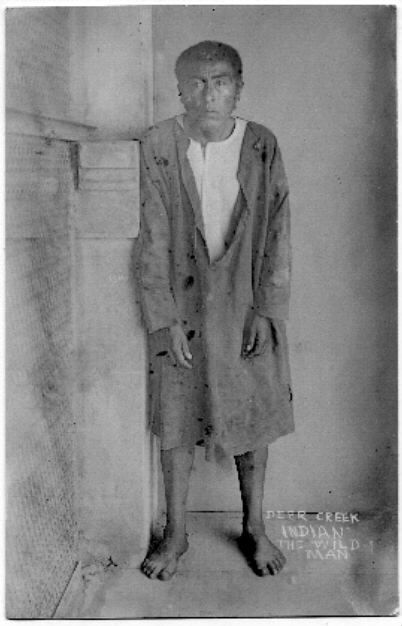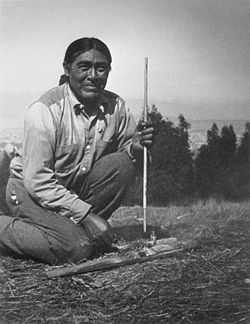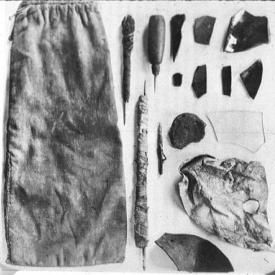 Ishi, the so-called “Last Yahi” may be the most famous Indian in California history ( in the photo at left, he is seen as he appeared when "discovered" near Oroville in 1911). But much of what has been taught about him over the past century has turned out to be wrong.
Ishi, the so-called “Last Yahi” may be the most famous Indian in California history ( in the photo at left, he is seen as he appeared when "discovered" near Oroville in 1911). But much of what has been taught about him over the past century has turned out to be wrong.
 Ishi in Two Worlds, the best-known story of Ishi’s life was written by Theodora Krober, the wife of the University of California anthropologist who worked with Ishi most extensively, and published in 1961, well after both men had died. It’s a romanticized, not particularly factual account, but Nicole Lum of the California Indian Museum and Cultural Center in Santa Rosa says that even during Ishi’s lifetime, his personal history was subject to revisionist displays.
Ishi in Two Worlds, the best-known story of Ishi’s life was written by Theodora Krober, the wife of the University of California anthropologist who worked with Ishi most extensively, and published in 1961, well after both men had died. It’s a romanticized, not particularly factual account, but Nicole Lum of the California Indian Museum and Cultural Center in Santa Rosa says that even during Ishi’s lifetime, his personal history was subject to revisionist displays.
Ishi: A Story of Dignity, Hope and Courage is the first permanent exhibit at the museum, near Larkfield. But Lum explains they have detailed plans to fill the rest of their spacious facility, as they are able to secure the necessary funding.

 From the Museum's text introducting the exhibit: "Among California Indians, none have figured more prominently in the public eye than Ishi. When Ishi arrived out of the foothills of Northern California into the town of Oroville in 1911, he was mistakenly characterized as a “wild” and “primitive” Indian, the “last of a Stone Age tribe”. These assumptions caused him to be brought to the University of California, Museum of Anthropology in San Francisco as a research subject by anthropologist, Alfred Kroeber. Ishi remained at the museum and shared cultural and historical information with scientists and the public during his five-year residence. He passed away in 1916 after having contracted tuberculosis while in San Francisco. Despite his close friendship with Kroeber and other University luminaries, at death, his remains were subjected to the indignity of an autopsy. His brain was removed in the interests of science. It disappeared for 83 years and resurfaced in a glass jar on a Smithsonian Institute shelf in 1999 after Ishi’s tribal relations mounted a successful effort to repatriate his remains under the Native American Graves Protection and Repatriation Act."
From the Museum's text introducting the exhibit: "Among California Indians, none have figured more prominently in the public eye than Ishi. When Ishi arrived out of the foothills of Northern California into the town of Oroville in 1911, he was mistakenly characterized as a “wild” and “primitive” Indian, the “last of a Stone Age tribe”. These assumptions caused him to be brought to the University of California, Museum of Anthropology in San Francisco as a research subject by anthropologist, Alfred Kroeber. Ishi remained at the museum and shared cultural and historical information with scientists and the public during his five-year residence. He passed away in 1916 after having contracted tuberculosis while in San Francisco. Despite his close friendship with Kroeber and other University luminaries, at death, his remains were subjected to the indignity of an autopsy. His brain was removed in the interests of science. It disappeared for 83 years and resurfaced in a glass jar on a Smithsonian Institute shelf in 1999 after Ishi’s tribal relations mounted a successful effort to repatriate his remains under the Native American Graves Protection and Repatriation Act."
Click here to read more about the Ishi exhibit at the California Indian Museum and Cultural Center in Santa Rosa.
 This set of tools is a replic a of those used by Ishi to demonstrate his technique for making arrowheads and other blades from obsidan and pieces of glass.
This set of tools is a replic a of those used by Ishi to demonstrate his technique for making arrowheads and other blades from obsidan and pieces of glass.

What we don’t know about insects could—and just about does—fill an entire planet. But what we do know makes for an interesting event tomorrow on the Sonoma State University campus.
 Insecta-palooza is a catchy name for the event, but Frederique Laviopierre (right) confides that it wasn’t the one they started with.
Insecta-palooza is a catchy name for the event, but Frederique Laviopierre (right) confides that it wasn’t the one they started with.
When she came to KRCB to talk about this event, Laviopierre brought along a six-legged companion she introduced as her favorite bug, at least for right now.
The images below are examples of the Australian stick bug, isloated to give you a good look at left, and a young one in its natural environment at the right.


These images of the Australian stick bug are taken from the webpage of another fan of the insects, which has more pictures and additional information here.
 A new “Community Benefit Agreement” between the developers of the big Sonoma Mountain Village project in Rohnert Park and a coalition of labor, housing and environmental groups could set a new standard for cooperation between factions that have more often been adversaries.
A new “Community Benefit Agreement” between the developers of the big Sonoma Mountain Village project in Rohnert Park and a coalition of labor, housing and environmental groups could set a new standard for cooperation between factions that have more often been adversaries.
 David Grabill with the Housing Advocacy Group was one of the first to contact Codding Enterprises about the Sonoma Mountain Village project. He recalls that after some encouraging early meetings, it soon became apparent that it would be more productive to engage the full Affordable Development Coalition in the ongoing talks.
David Grabill with the Housing Advocacy Group was one of the first to contact Codding Enterprises about the Sonoma Mountain Village project. He recalls that after some encouraging early meetings, it soon became apparent that it would be more productive to engage the full Affordable Development Coalition in the ongoing talks.
Kirstie Moore, development manager for the Sonoma Mountain Village project (seen fully built out in this artist's rendering), says the lengthy negotiations with the Affordable Development Coalition (ADC) were a learning experience for both sides.

The voluntary agreement with Codding Enterprises is legally binding for Sonoma Mountain Village is concerned, but for other development projects, says ADC Director Marlene Dehlinger, it represents a standard to live up to, not a requirement that anyone else is obligated to meet.

The Redwood Empire Food Bank has seen their client base grow by 40% over the past two years, and has added some innovative new ways to serve them.
 The development of the Redwood Empire Food Bank’s new “3 Squares” prepackaged meals, explains Executive Director David Goodman, grew out of a large donation of a single ingredient.
The development of the Redwood Empire Food Bank’s new “3 Squares” prepackaged meals, explains Executive Director David Goodman, grew out of a large donation of a single ingredient.
 The “3 Squares” meals are now being offered in three flavors: Black Bean Chili, Pasta with Marinara Sauce, and Spanish Rice. They were deliberately made not to be microwavable, Goodman adds, but to reinforce the idea of dinner as an event for the family to share.
The “3 Squares” meals are now being offered in three flavors: Black Bean Chili, Pasta with Marinara Sauce, and Spanish Rice. They were deliberately made not to be microwavable, Goodman adds, but to reinforce the idea of dinner as an event for the family to share.

 Sonoma County inventor James McElvaney (right), has developed a system to convert organic waste into energy and other beneficial byproducts, one that creates the energy that powers it in the bargain.
Sonoma County inventor James McElvaney (right), has developed a system to convert organic waste into energy and other beneficial byproducts, one that creates the energy that powers it in the bargain.
Bob Hillman, McElvaney's partner in their start-up, Bioconverter LLC, sees their new technology as a tool to capture greenhouse gases while also combating invasive, non-native plants, such as the Ludwigia, or Creeping Water Primrose, now prevalent in the Laguna de Santa Rosa.
The company offers a more comprehensive explanation of their processes on the FAQ page of their website, but you can read an overview here.
 The primary process of bioconversion takes place in a series of vertical tanks, such as those seen at left. In addition to the environmental benefits of bioconversion, Hillman notes that it has the economic potential to actually fund some of those productive outcomes.
The primary process of bioconversion takes place in a series of vertical tanks, such as those seen at left. In addition to the environmental benefits of bioconversion, Hillman notes that it has the economic potential to actually fund some of those productive outcomes.

 Live Radio
Live Radio